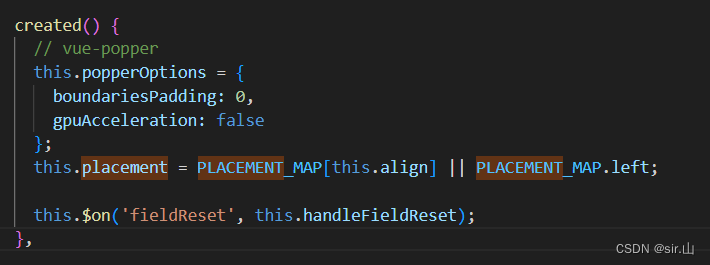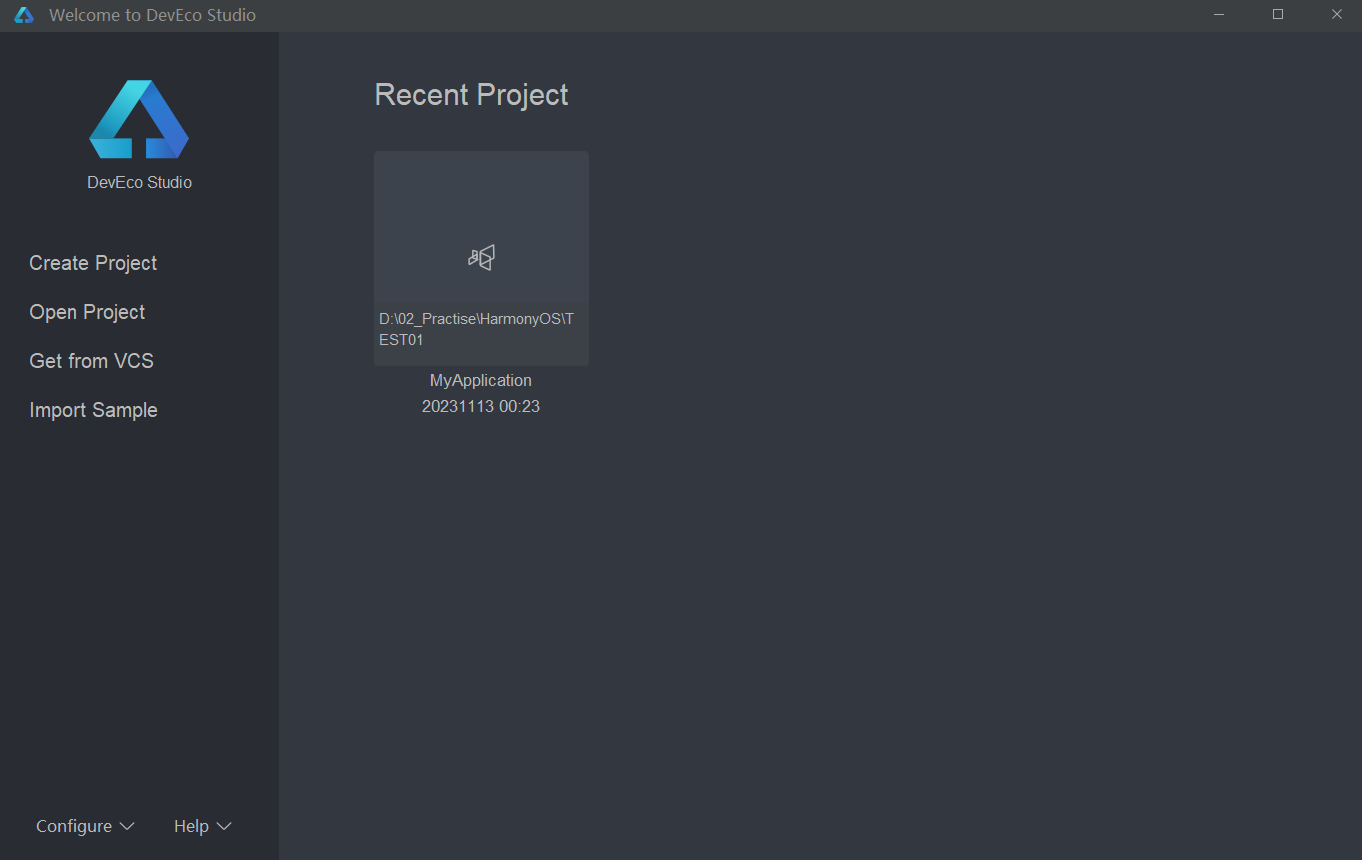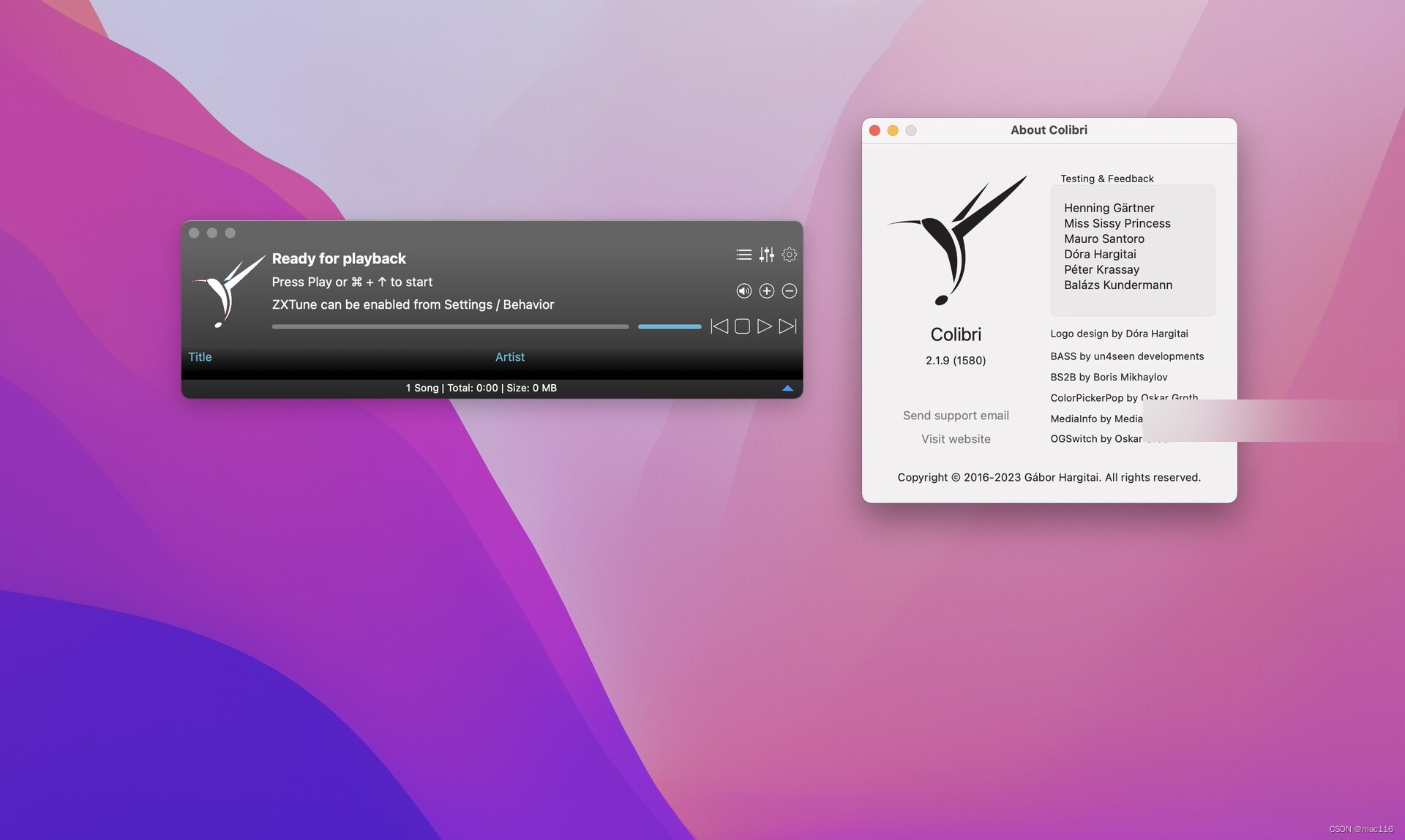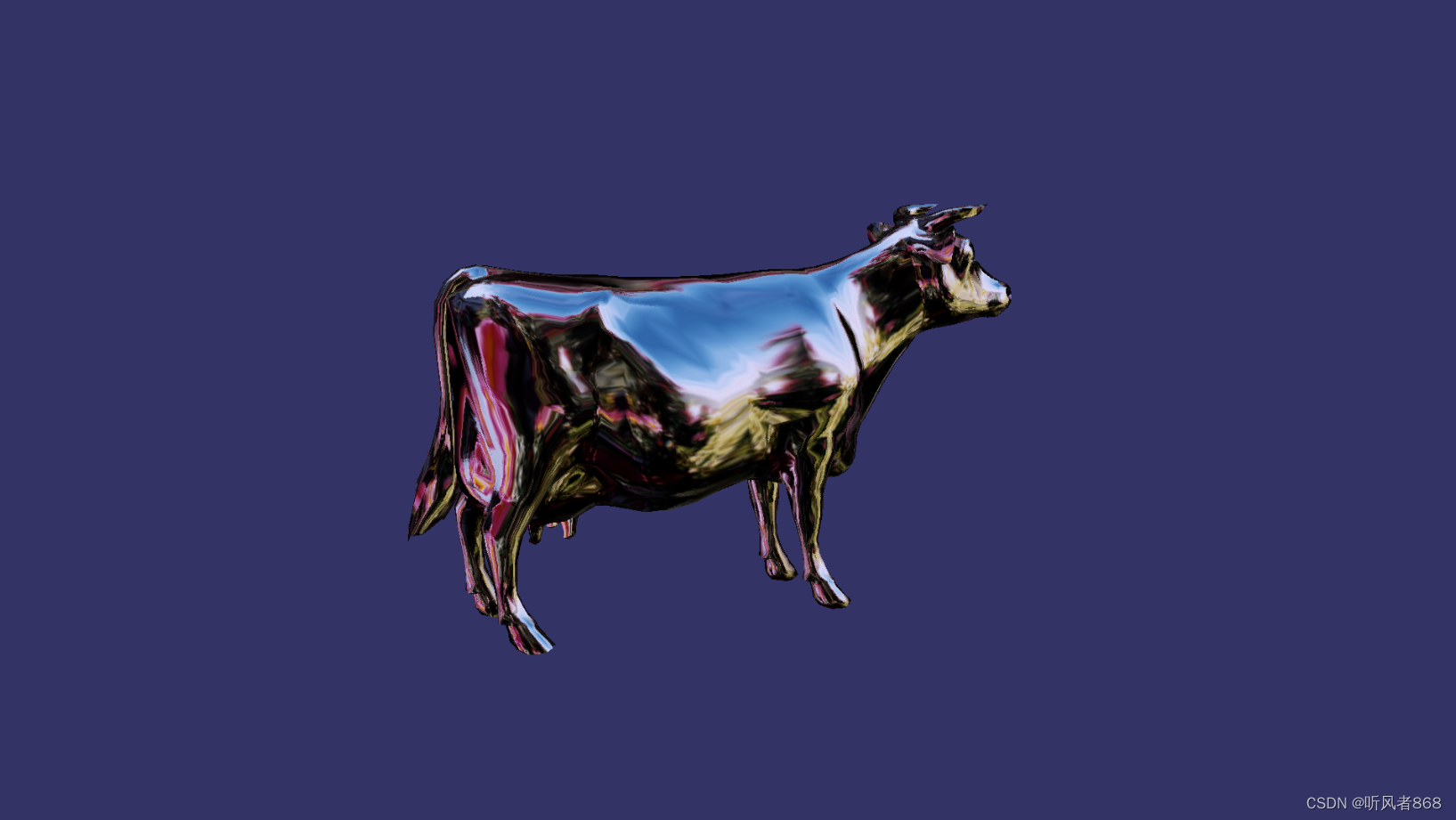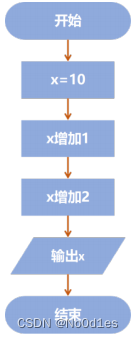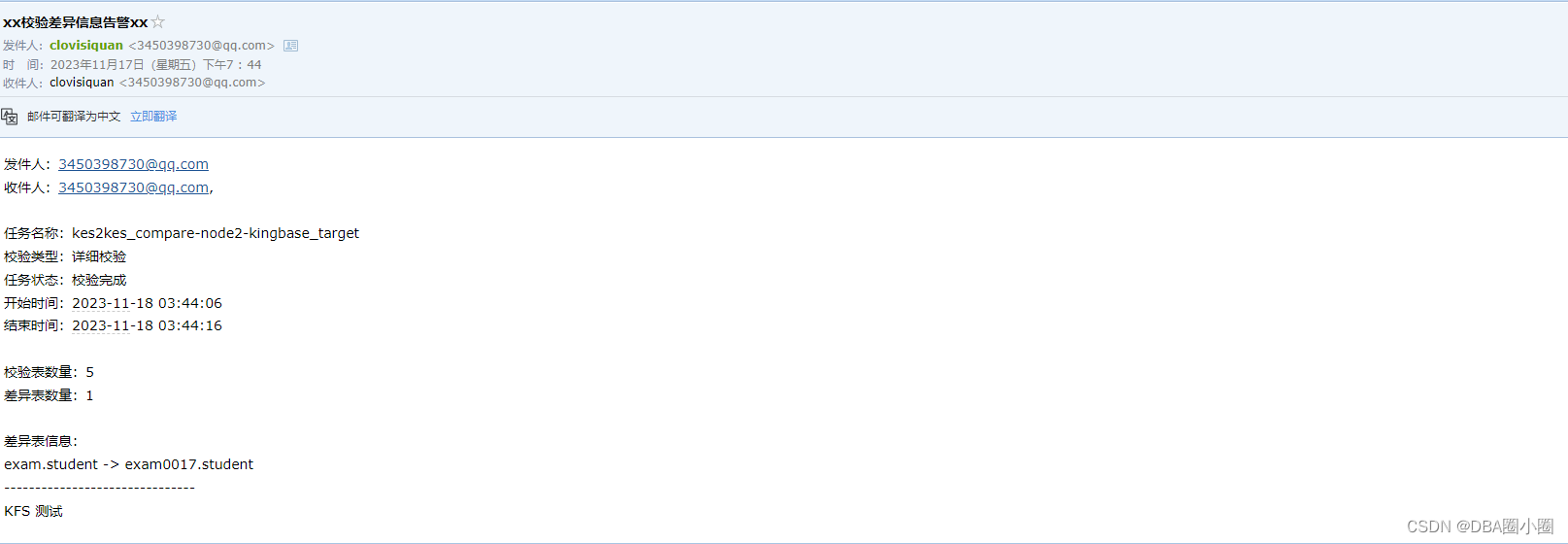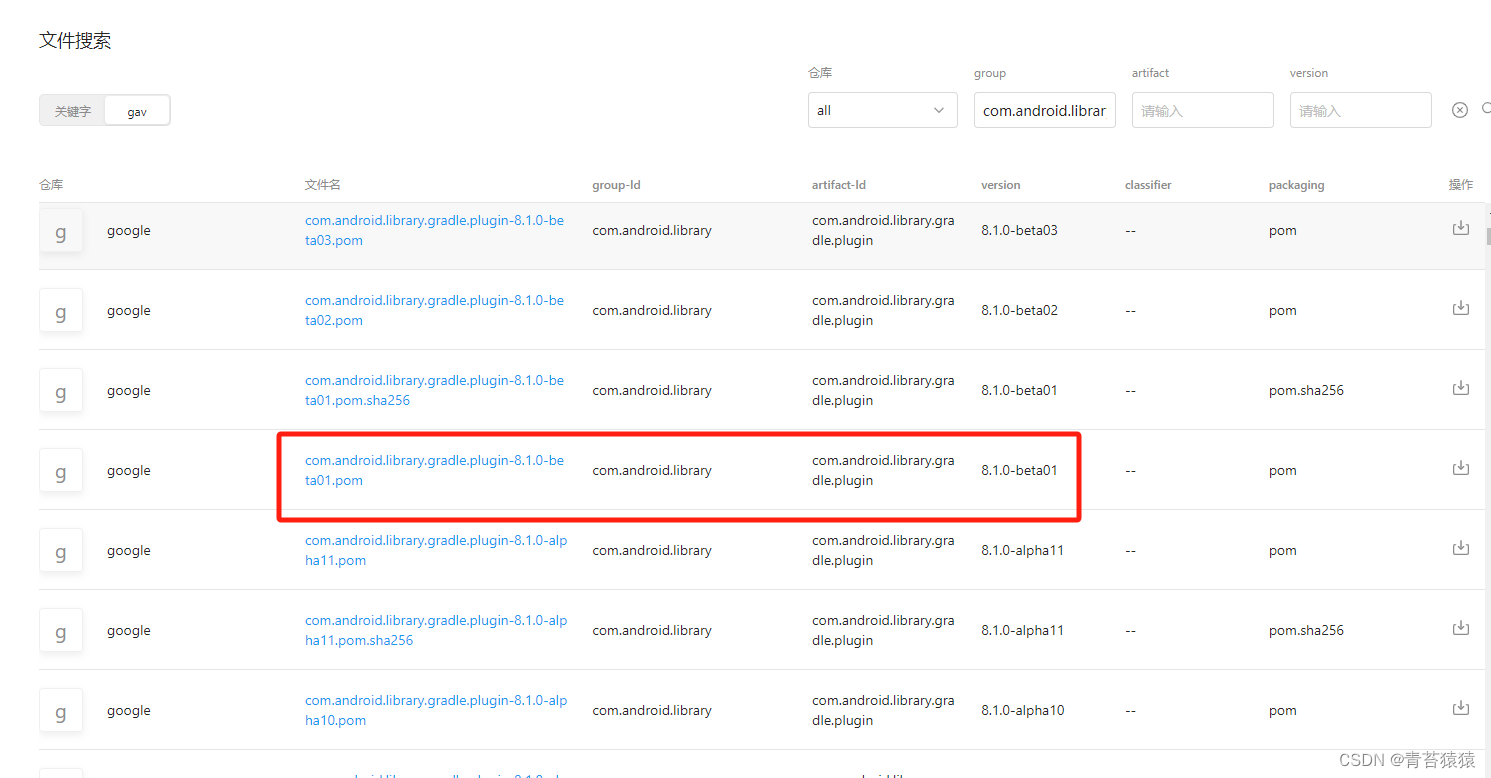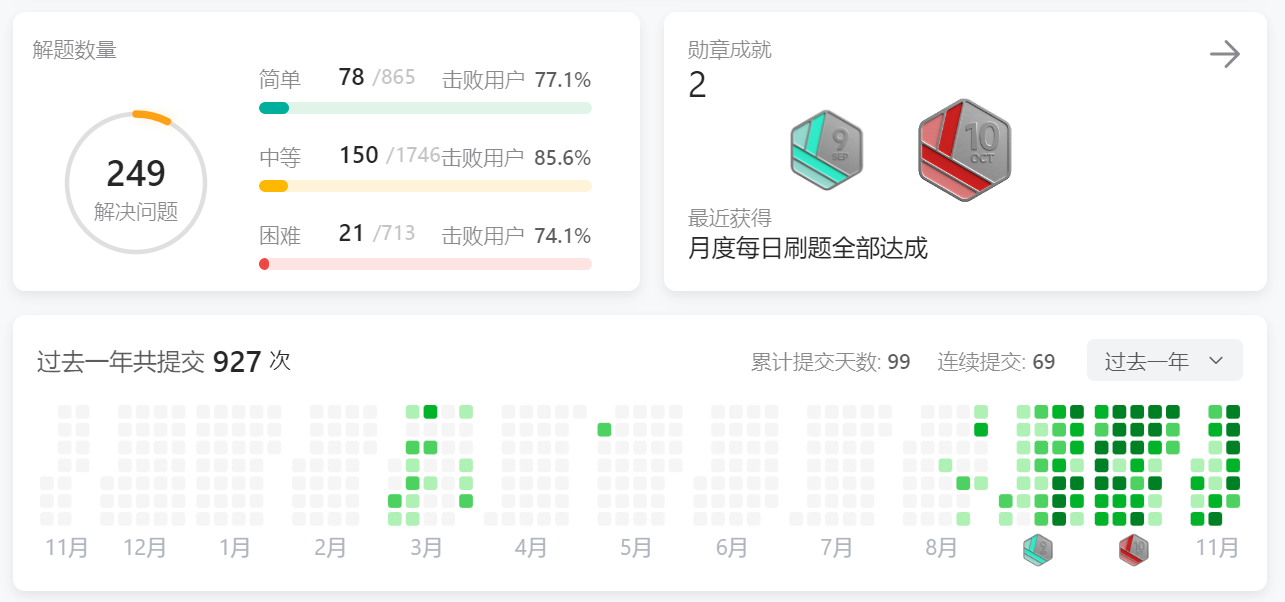机器学习模型已经变得越来越大,以至于训练模型可能会给那些没有空闲集群的人带来痛苦。 此外,即使使用训练好的模型,当你的硬件与模型对其运行的期望不符时,推理的时间和内存成本也会飙升。 因此,为了缓解这个问题,我们并没有放弃类似 BERT 模型的深层知识,而是开发了一种称为蒸馏(distillation)的技术,将网络缩小到合理的大小,同时最大限度地减少性能损失。
如果你已经阅读了本系列的第一篇文章,那么这并不是什么新闻。 在其中,我们讨论了 DistilBERT 如何引入一种简单而有效的蒸馏技术,可以轻松应用于任何类似 BERT 的模型,但我们避开了任何具体的实现。 现在,我们将详细介绍如何将想法转化为 .py 文件。

在线工具推荐: Three.js AI纹理开发包 - YOLO合成数据生成器 - GLTF/GLB在线编辑 - 3D模型格式在线转换 - 可编程3D场景编辑器
1、学生模型的初始化
由于我们想要从现有模型初始化一个新模型,因此需要访问旧模型(即教师)的权重。 我们假设预先存在的模型是在 PyTorch 上实现的 Hugging Face 模型, 因此,要获得权重,首先必须知道如何访问它们。 我们将使用 RoBERTa large 作为我们的教师模型。
1.1 Hugging Face的模型结构
我们可以尝试的第一件事是打印模型结构,这应该让我们深入了解它是如何制作的。 当然,我们总是可以深入研究 Hugging Face 文档 ,但这并不有趣。
from transformers import AutoModelForMaskedLM
roberta = AutoModelForMaskedLM.from_pretrained("roberta-large")
print(roberta)运行此代码后,我们得到:
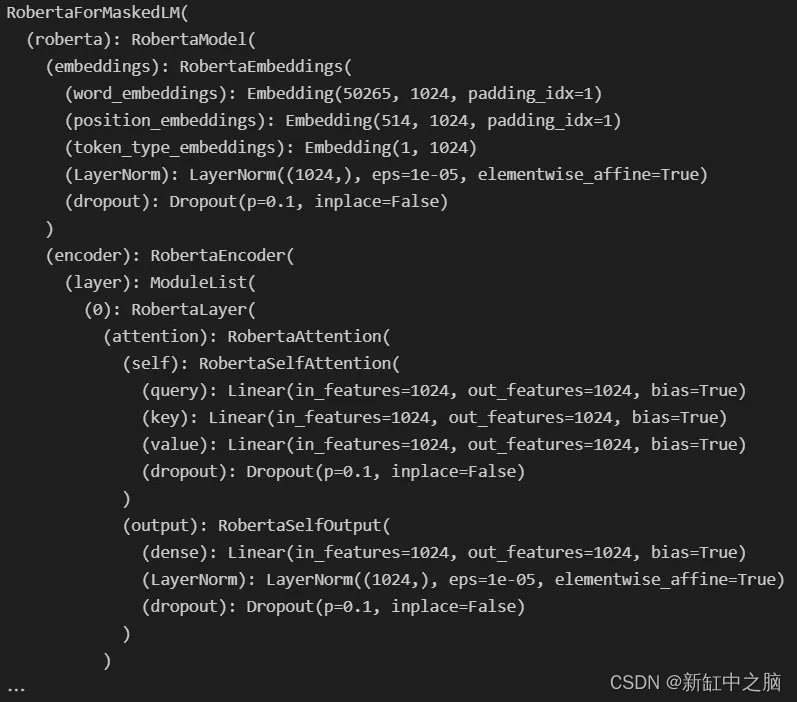
简单打印 RoBERTA 的第一印象
模型的结构开始出现,但我们可以让它变得更漂亮。 在 Hugging Face 模型中,我们可以使用 .children() 生成器访问模块的子组件。 因此,如果我们想要遍历整个模型,我们需要在其上调用 .children() ,并在每个产生的子级上继续调用 .children() ,等等......这描述了一个递归函数,代码如下:
from typing import Any
from transformers import AutoModelForMaskedLM
roberta = AutoModelForMaskedLM.from_pretrained("roberta-large")
def visualize_children(
object : Any,
level : int = 0,
) -> None:
"""
Prints the children of (object) and their children too, if there are any.
Uses the current depth (level) to print things in a ordonnate manner.
"""
print(f"{' ' * level}{level}- {type(object).__name__}")
try:
for child in object.children():
visualize_children(child, level + 1)
except:
pass
visualize_children(roberta)输出结果如下:
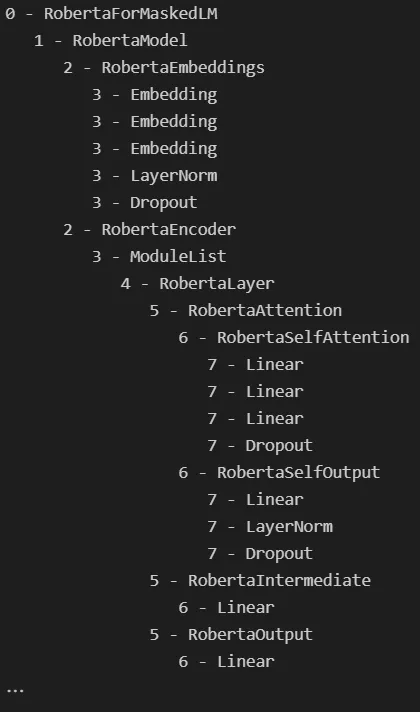
RoBERTa 的递归预览
通过展开这棵树,看起来 RoBERTa 模型的结构与其他类似 BERT 的模型一样,如下所示:
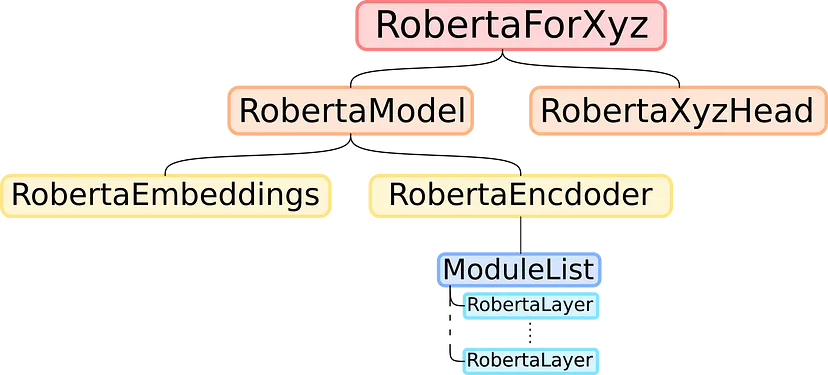
类 BERT 模型的架构
1.2 复制教师模型的权重
我们知道,要以 DistilBERT 的方式初始化类似 BERT 的模型,我们只需要复制除 Roberta 层最深层之外的所有内容,我们省略了其中的一半。
首先,我们需要创建学生模型,其架构与教师模型相同,但隐藏层数量只有一半。
为此,我们只需要使用教师模型的配置,它是一个类似字典的对象,描述了 Hugging Face 模型的架构。 当查看 roberta.config 属性时,我们可以看到以下内容:
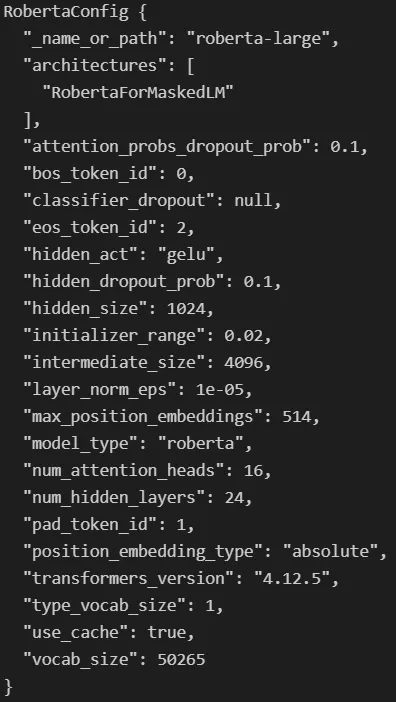
RoBERTa 配置
我们在这里感兴趣的是 num-hidden-layers 属性。 让我们编写一个函数来复制此配置,通过将其除以 2 来更改该属性,并使用新配置创建一个新模型:
from transformers.models.roberta.modeling_roberta import RobertaPreTrainedModel, RobertaConfig
def distill_roberta(
teacher_model : RobertaPreTrainedModel,
) -> RobertaPreTrainedModel:
"""
Distilates a RoBERTa (teacher_model) like would DistilBERT for a BERT model.
The student model has the same configuration, except for the number of hidden layers, which is // by 2.
The student layers are initilized by copying one out of two layers of the teacher, starting with layer 0.
The head of the teacher is also copied.
"""
# Get teacher configuration as a dictionnary
configuration = teacher_model.config.to_dict()
# Half the number of hidden layer
configuration['num_hidden_layers'] //= 2
# Convert the dictionnary to the student configuration
configuration = RobertaConfig.from_dict(configuration)
# Create uninitialized student model
student_model = type(teacher_model)(configuration)
# Initialize the student's weights
distill_roberta_weights(teacher=teacher_model, student=student_model)
# Return the student model
return student_model当然,这个函数引入了一个缺失的部分 distill_roberta_weights ,该函数会将教师模型权重的一半置于学生层中,但我们仍然需要对其进行编码。 由于递归对于探索教师模型效果很好,因此我们可以使用相同的想法来探索和复制其中的部分内容。 我们将同时浏览教师模型和学生模型,同时将部分内容从一个模型复制到另一个模型。 唯一的技巧是要小心隐藏层部分并只复制一半。实现代码如下:
from transformers.models.roberta.modeling_roberta import RobertaEncoder, RobertaModel
from torch.nn import Module
def distill_roberta_weights(
teacher : Module,
student : Module,
) -> None:
"""
Recursively copies the weights of the (teacher) to the (student).
This function is meant to be first called on a RobertaFor... model, but is then called on every children of that model recursively.
The only part that's not fully copied is the encoder, of which only half is copied.
"""
# If the part is an entire RoBERTa model or a RobertaFor..., unpack and iterate
if isinstance(teacher, RobertaModel) or type(teacher).__name__.startswith('RobertaFor'):
for teacher_part, student_part in zip(teacher.children(), student.children()):
distill_roberta_weights(teacher_part, student_part)
# Else if the part is an encoder, copy one out of every layer
elif isinstance(teacher, RobertaEncoder):
teacher_encoding_layers = [layer for layer in next(teacher.children())]
student_encoding_layers = [layer for layer in next(student.children())]
for i in range(len(student_encoding_layers)):
student_encoding_layers[i].load_state_dict(teacher_encoding_layers[2*i].state_dict())
# Else the part is a head or something else, copy the state_dict
else:
student.load_state_dict(teacher.state_dict())该函数通过递归和类型检查,确保学生模型与教师模型相同,对于 Roberta 层来说是安全的。 可以注意到,如果我们想在初始化教师模型时更改复制哪些层,则只有编码器部分中的 for 循环需要更改。
现在我们有了学生模型,我们需要训练它。 除了要使用的损失函数之外,这部分相对简单。
2、自定义损失函数
作为对 DistilBERT 训练过程的回顾,我们可以看下图:
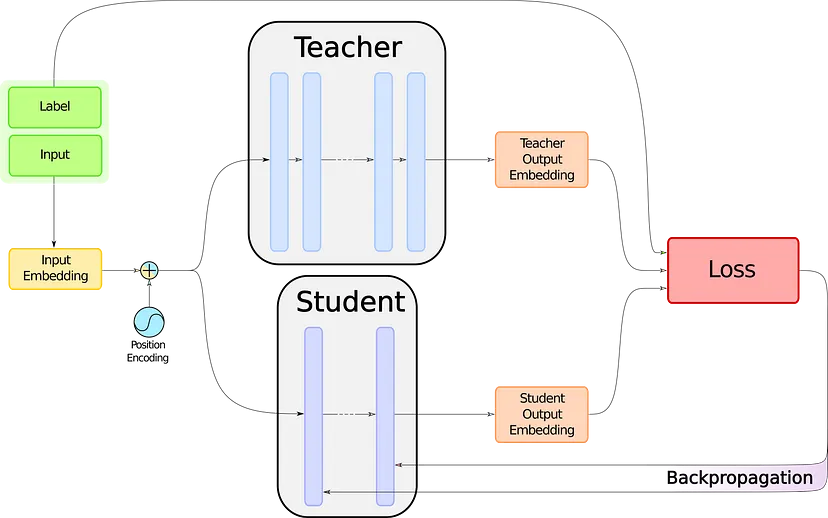
DistilBERT 的蒸馏过程
我们将把注意力转向那个写着 LOSS 的红色大盒子。 但在揭示里面有什么之前,我们需要知道如何收集我们要喂它的东西。 从这张图中,我们可以看到我们需要三样东西:标签、学生模型和教师模型的嵌入。 标签,我们已经有了,否则,我们可能会遇到更大的问题。 现在让我们得到另外两个。
2.1 检索教师和学生的输入
在这里,我们将坚持我们的示例并使用带有分类头的 RoBERTa 来说明这部分。 我们需要的是一个函数,给定类似 BERT 模型的输入,即两个张量( input_ids 和 Attention_mask)以及模型本身,将返回该模型的输出 logits。
由于我们使用的是 Hugging Face,所以这非常简单,我们唯一需要的知识就是看哪里。
from torch import Tensor
def get_logits(
model : RobertaPreTrainedModel,
input_ids : Tensor,
attention_mask : Tensor,
) -> Tensor:
"""
Given a RoBERTa (model) for classification and the couple of (input_ids) and (attention_mask),
returns the logits corresponding to the prediction.
"""
return model.classifier(
model.roberta(input_ids, attention_mask)[0]
)我们为学生模型和老师模型都执行这个操作,第一个有梯度,第二个没有梯度。
2.2 损失函数计算
如果损失函数有点不透明,我们建议你返回第一篇文章来阅读损失函数。 但是,如果没有时间这样做,下图应该会有所帮助:

DistilBERT 的损失
我们所说的 Converging consine loss(收敛余弦损失)是用于对齐两个输入向量的常规余弦损失。 有关更多信息,请参阅该系列的第一部分。 这是代码:
import torch
from torch.nn import CrossEntropyLoss, CosineEmbeddingLoss
def distillation_loss(
teacher_logits : Tensor,
student_logits : Tensor,
labels : Tensor,
temperature : float = 1.0,
) -> Tensor:
"""
The distillation loss for distilating a BERT-like model.
The loss takes the (teacher_logits), (student_logits) and (labels) for various losses.
The (temperature) can be given, otherwise it's set to 1 by default.
"""
# Temperature and sotfmax
student_logits, teacher_logits = (student_logits / temperature).softmax(1), (teacher_logits / temperature).softmax(1)
# Classification loss (problem-specific loss)
loss = CrossEntropyLoss()(student_logits, labels)
# CrossEntropy teacher-student loss
loss = loss + CrossEntropyLoss()(student_logits, teacher_logits)
# Cosine loss
loss = loss + CosineEmbeddingLoss()(teacher_logits, student_logits, torch.ones(teacher_logits.size()[0]))
# Average the loss and return it
loss = loss / 3
return loss3、更优雅的实现
我希望你不会对 Python 是一种面向对象的编程语言感到震惊。 因此,由于所有这些函数都使用几乎相同的对象,因此不让它们成为类的一部分似乎很奇怪。 如果你想实现这一点,我建议使用 Distillator 类来整理代码,就像这个gist 。 我们不会嵌入这个,因为它很长。
当然,缺少一些东西,比如 GPU 支持、整个训练例程等。但是 DistilBERT 的所有关键思想都可以在那里找到。
4、蒸馏结果
那么以这种方式提炼出来的模型最终表现如何呢? 对于DistilBERT,可以阅读原论文。 对于 RoBERTa,Hugging Face 上已经存在类似 DistilBERT 的精简版本,就在这里。 在 GLUE 基准测试 上,我们可以比较这两个模型:

RoBERTa 与 DistilRoBERTa的对比
至于时间和内存成本,该模型的大小大约是 roberta-base 的三分之二,速度是 roberta-base 的两倍。
5、结束语
通过本系列文章,你应该拥有足够的知识来提炼遇到的任何类似 BERT 的模型。 但为什么要停在那里呢? 大自然充满了蒸馏方法,例如 TinyBERT 或 MobileBERT。 如果你认为其中一个更适合你的需求,那么应该阅读这些文章。 谁知道呢,你可能想尝试一种新的蒸馏方法,因为这是一个日益发展的领域。
原文链接:类 BERT 模型蒸馏实战 - BimAnt

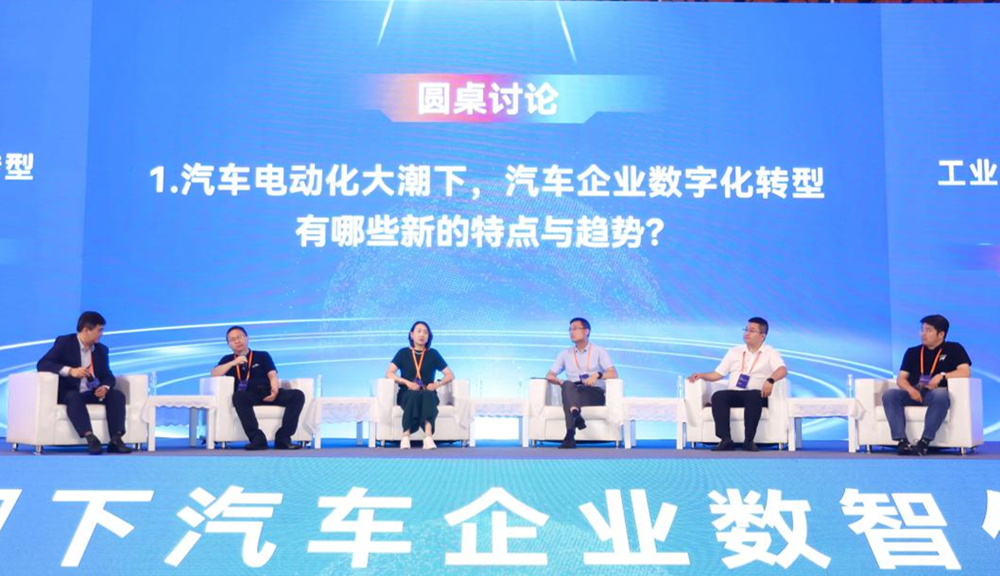
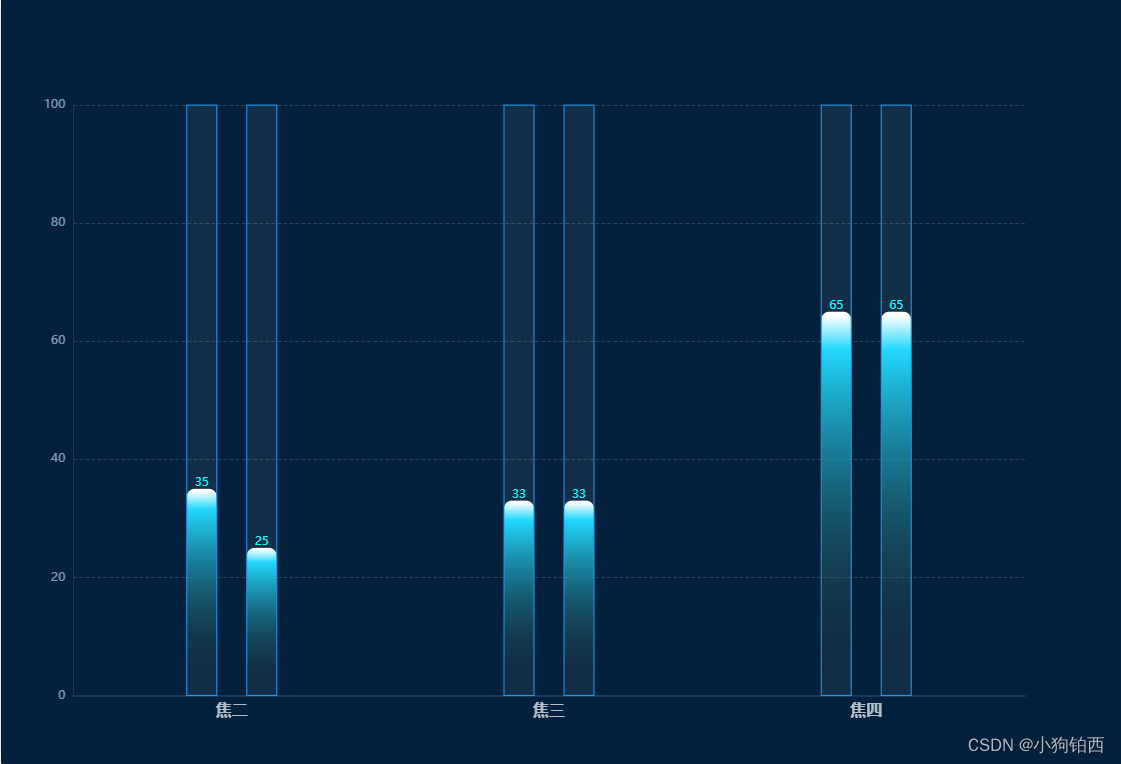
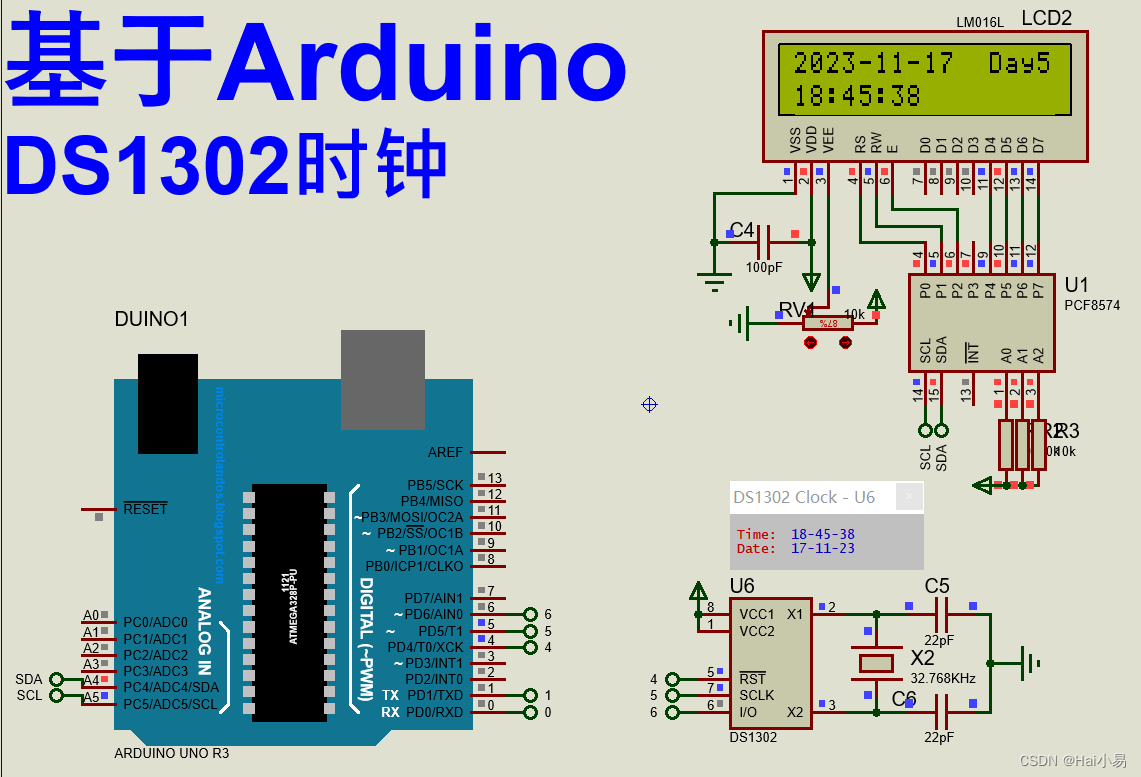
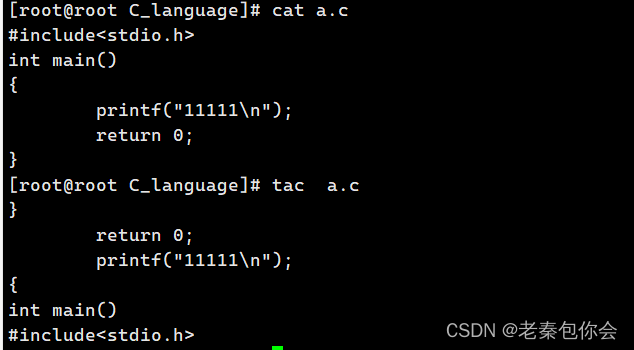
![23111703[含文档+PPT+源码等]计算机毕业设计javaweb商城项目全套电商购物系统](https://img-blog.csdnimg.cn/img_convert/c29addac773c41d1f06f8f8986be6cae.png)


